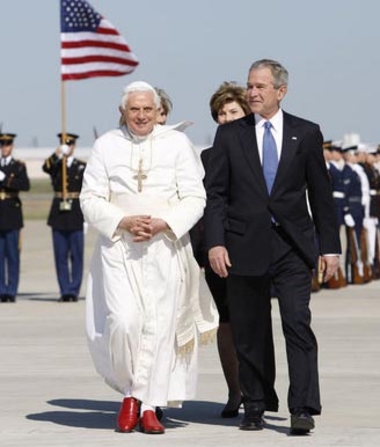Religious threads

By Charlotte Allen,McClatchy Times News Service/Los Angeles Times, via the AP.
I’m a Catholic, but I’ll admit it (or should I say “confess” it?): When Pope Benedict XVI announced his pending resignation, my first thought wasn’t religious. It was in fact downright superficial. “There goes the best-dressed pontiff ever!”
During his nearly eight years on the throne of St. Peter, Benedict has always looked absolutely perfect, sartorially speaking, whether garbed in elaborate vestments for an Easter liturgy or clad in the simple but meticulously tailored white caped cassock (it’s called a “simar” in church lingo) that he wears on more ordinary occasions. He’s been the Duke of Windsor of popes.
My own fashion sense is nearly nonexistent, but that only makes me more appreciative of Benedict’s. Some highlights: Benedict saying Mass in 2008 at Washington’s Nationals Park stadium in a billowing scarlet satin chasuble (a priest’s outermost liturgical garment) trimmed with crimson velvet and delicate gold piping. Benedict greeting worshipers in Rome, his chasuble this time woven of emerald-green watered silk with a pattern of golden stars. Benedict on Oct. 21 canonizing Kateri Tekakwitha, the first Native American saint, while attired in a fanon, a gold-and-white striped shoulder covering, dating to the 8th century, that only popes may wear.
Benedict’s immediate predecessor, Pope John Paul II, was a saintly figure and a commanding intellectual presence, but he had little interest in clothes, tending to wear whatever was handed to him and shunning elaborate adornments. Pope Paul VI, who reigned from 1963 to 1978, started out dressing fancy, but he gradually simplified his attire, abandoning, for example, the papal tiara, the high triple crown that popes had worn since the early Middle Ages.
Benedict didn’t bring back the tiara, but he has revived many other traditional papal garments and accessories. For his public appearances he almost always wears the bright red shoes that popes have worn since Roman times (John Paul preferred brown or black footwear). Benedict also began wearing the mozzetta, a waist-length cape, and the camauro, a red velvet cap with a white fur border that reminded Americans of a Santa Claus hat. Neither of those items had been seen much on popes since the end of the Second Vatican Council in 1965.
Benedict’s sartorial revivals have offended many liberal Catholics, who argue that he has been trying to “turn back the clock,” as they often put it, on the churchly reforms of Vatican II. The cattiest critic was Hans Kung, the dissident German priest who had once been a colleague of Benedict, or Josef Ratzinger as he was then called, on the faculty of the University of Tubingen. In a 2008 op-ed article for the Italian newspaper La Stampa, Kung called Benedict’s style of dress “pompous” and compared him to Pope Leo X of the 16th century, notorious for selling indulgences and famously painted by Raphael in fur-trimmed mozzetta and camauro.
Others have used the phrases “over the top” and “major bling” to describe Benedict’s taste in vestments, deeming the pope a foppish aesthete. Still others, such as the gay blogger Andrew Sullivan, have speculated that Benedict is himself gay. Catholic conservatives counter that Benedict’s attire exemplifies a “hermeneutic of continuity,” a deliberate symbolic effort to link his 21st century papacy to centuries of Catholic tradition.
My own take on Benedict’s wardrobe is somewhat different. I don’t believe that aesthetics is mere window-dressing. In her 2005 book “The Substance of Style,” economics pundit Virginia Postrel wrote: “Aesthetics is the way we communicate through the senses…. Aesthetics shows rather than tells, delights rather than instructs. The effects are immediate, perceptual and emotional.” Plato argued that the beautiful, while not exactly the same as the good, is a kind of complement to the good that points to the good and shows off the good via sensory media.
That is what I believe is exactly Benedict’s aim. Over the last couple of decades, the Roman Catholic Church has been besmirched with ugliness, scarred by clerical sexual predation abetted by clueless and self-promoting bishops. Benedict has used beauty to demonstrate tangibly that the Catholic faith that he and the members of his church share is itself beautiful and indestructible, and that it shines through despite all human efforts to wreck it.
It is especially fitting for our time that the pope has chosen his own liturgical apparel as an aesthetic medium. In the world of what passes for sophisticated culture these days, beauty and art have become nearly unmoored from each other. Art is supposed to be transgressive, while beauty is judged merely ornamental. Paint a Madonna, and you’ve got calendar kitsch. Paint a Madonna, and add some elephant dung and pictures of female genitalia cut out from porn magazines, and you’ve got a work to be exhibited in an exclusive gallery. Only in the decorative and useful arts — jewelry, fabrics, home furnishings, clothing, the design of cars, machines, and even humble objects — are beauty and fine craftsmanship still the criteria by which we judge value.
Pope Benedict XVI has been the pope of aesthetics, the pope who plays Mozart on the piano for his own private entertainment and who can write theological books in such lucid, limpid prose that ordinary people can read them for pleasure. He has reminded a world that looks increasingly ugly and debased that there is such a thing as the beautiful — whether it’s embodied in a sonata or an altarpiece or an embroidered cope or the cut of a cassock — and that earthly beauty ultimately communicates a beauty that is beyond earthly things.





